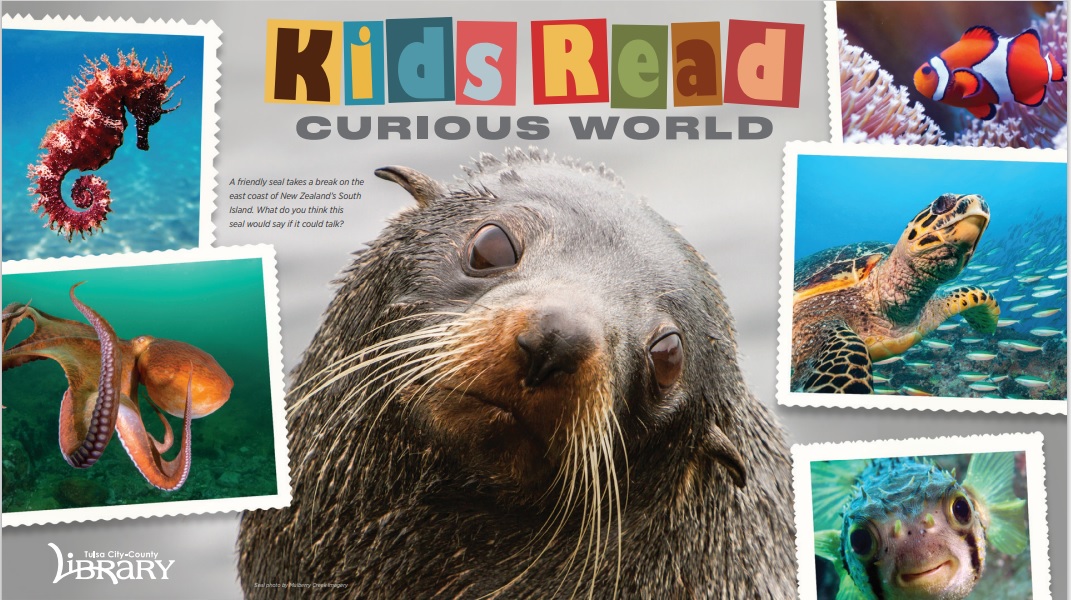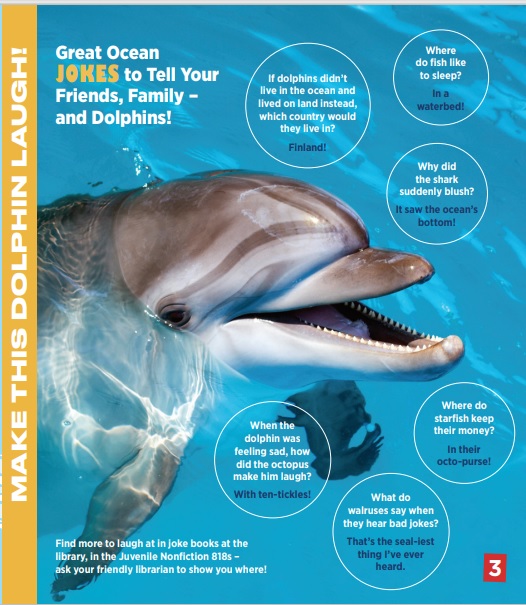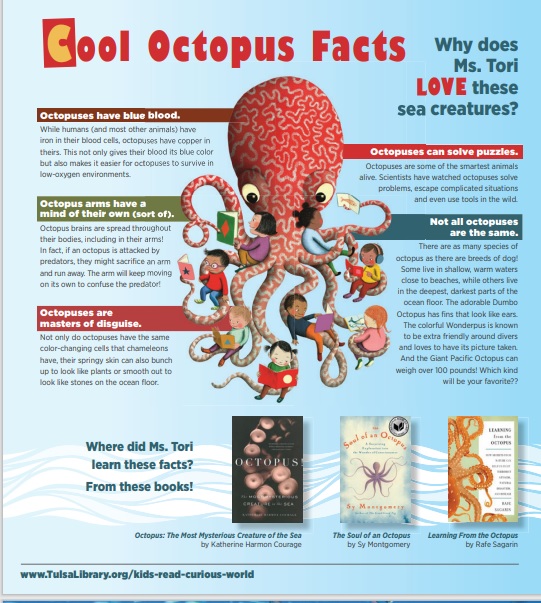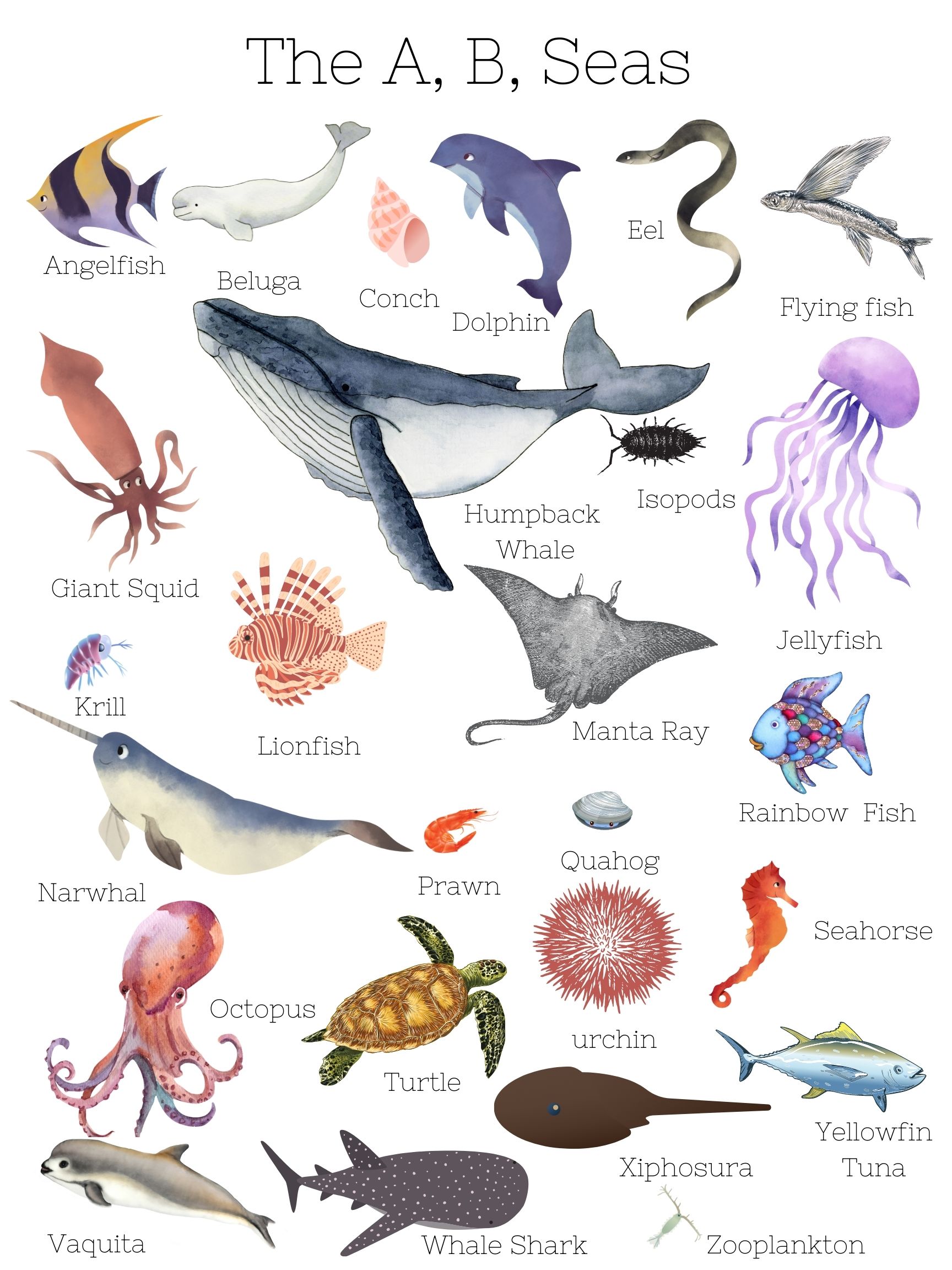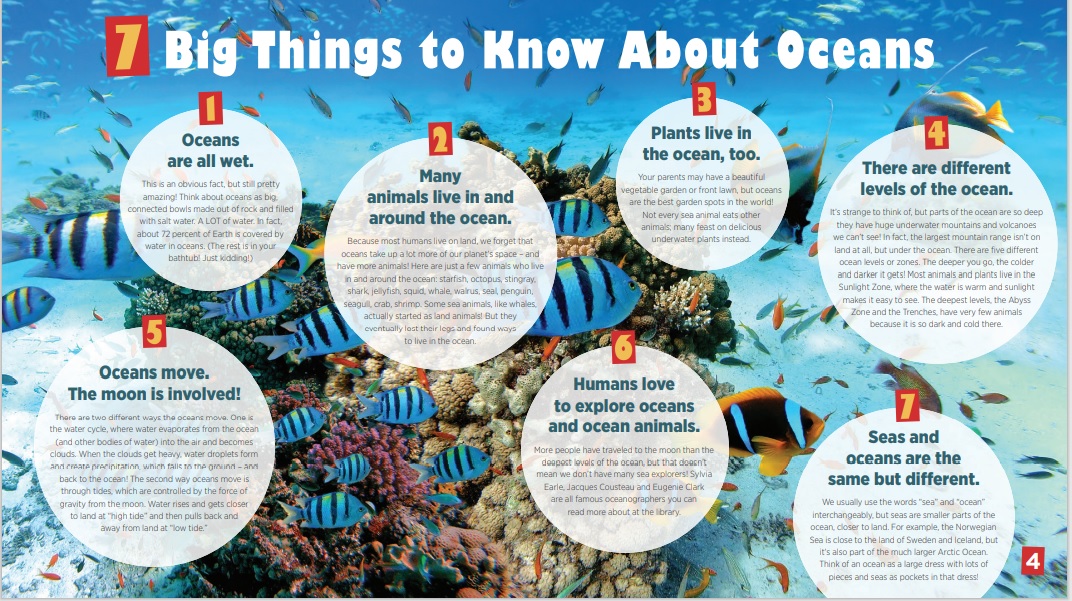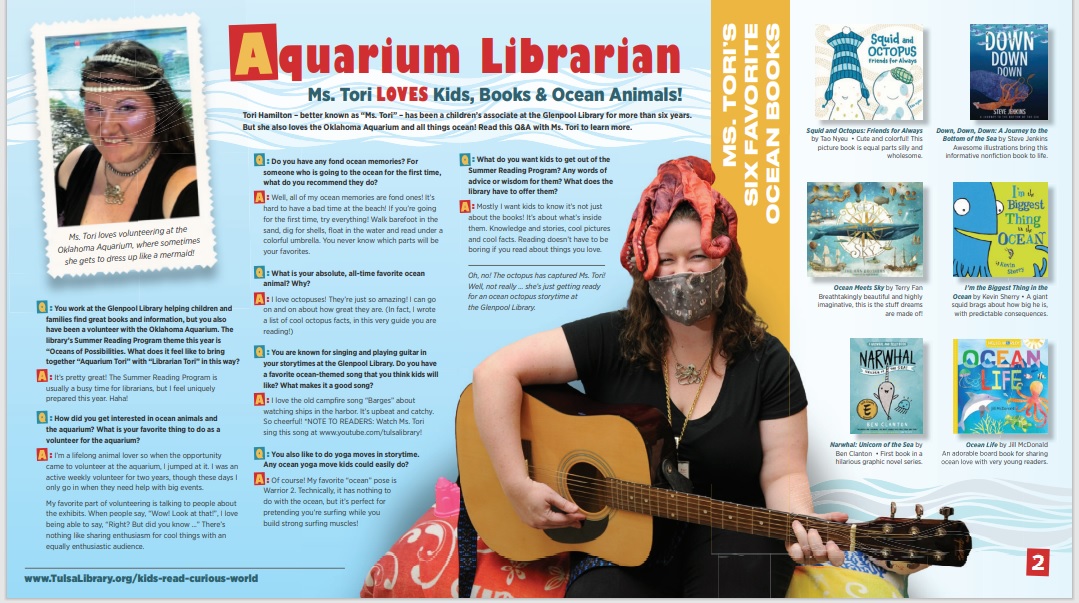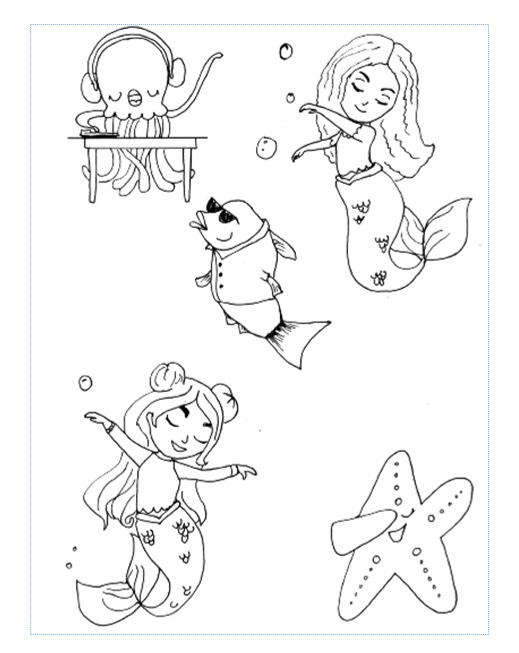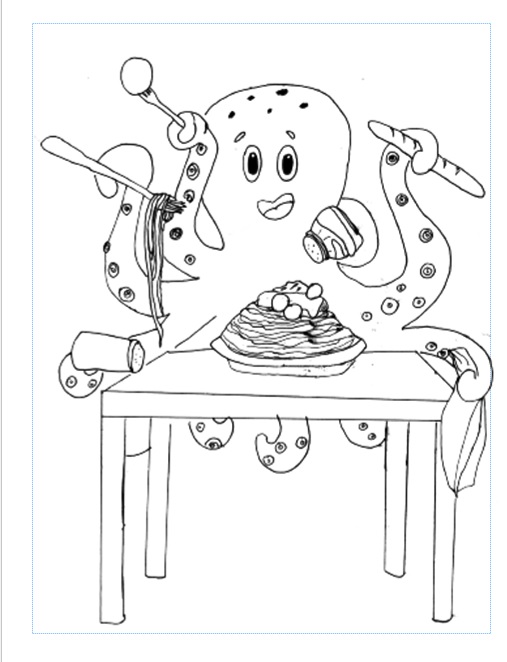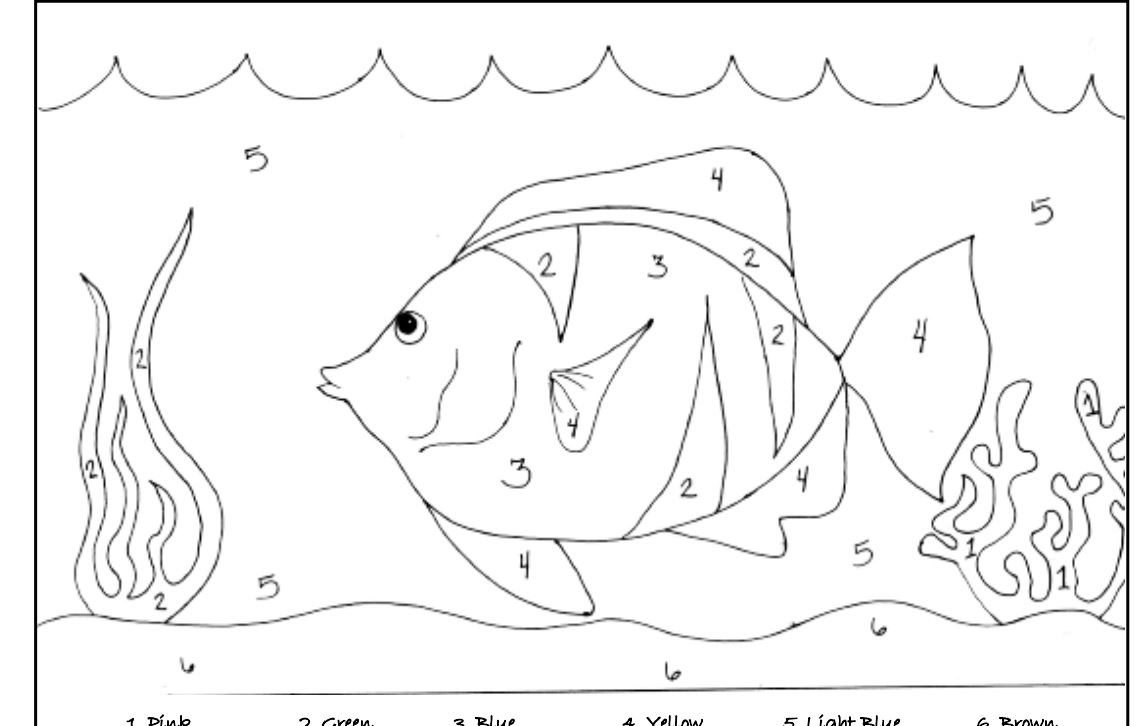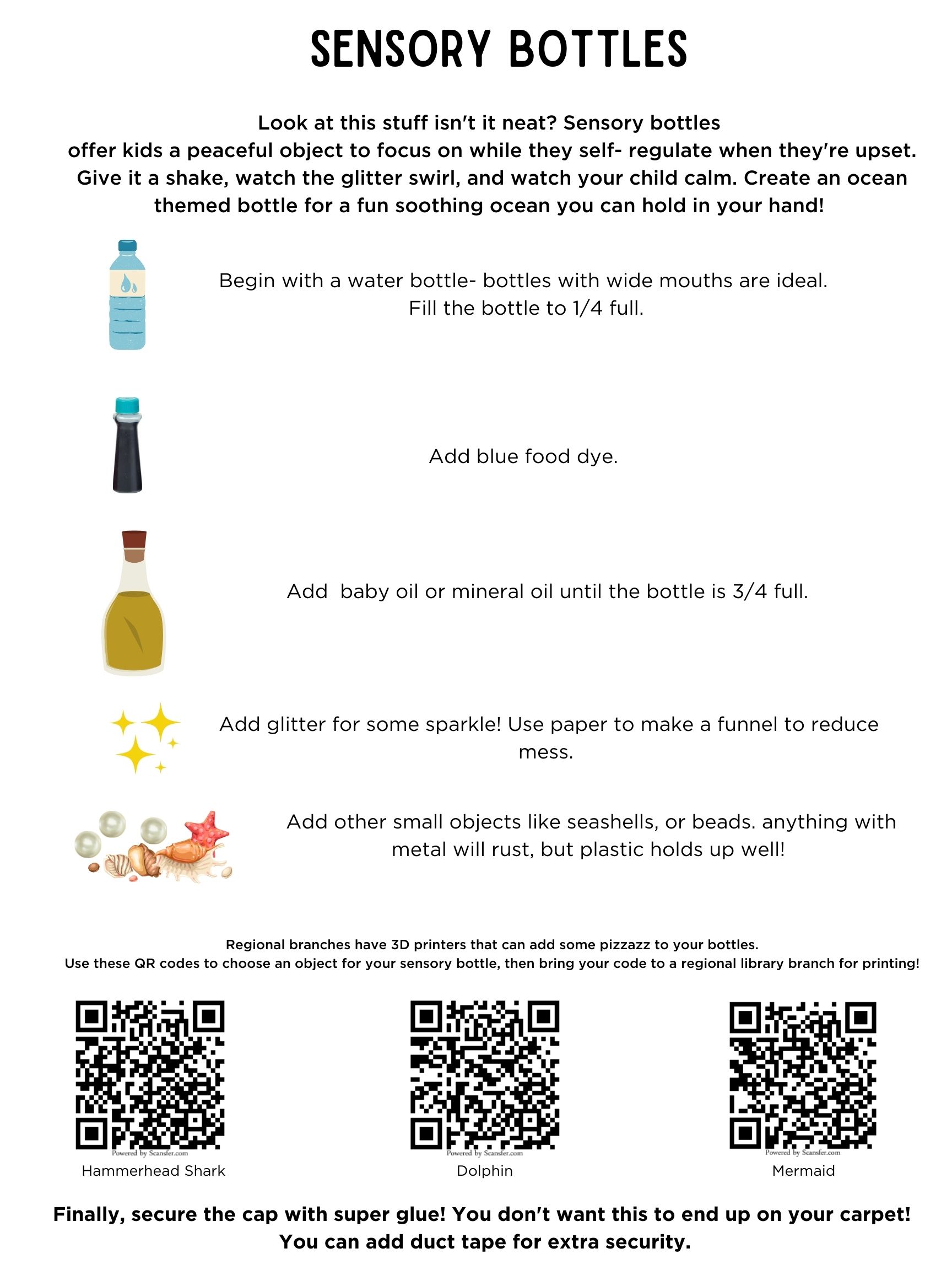Explore the OCEAN and all of its possibilities!
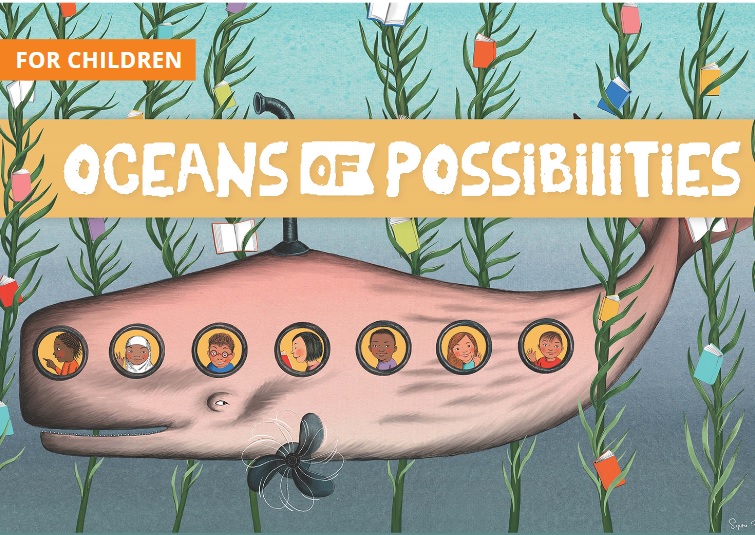
Kids Read Magazine: Oceans!
Download and print this awesome Kids Read Curious World magazine devoted to OCEANS!
https://www.tulsalibrary.org/sites/default/files/2022-06/TCCL_SRP_Kids-Read_22_1920x1080.pdf
Kids Read Curious Detective: Oceans
Dive deep into learning more about oceans and ocean animals! These books are perfect for kids who like learning about the real world - and want to know more about oceans!
Kids Read Connector: Oceans
Get connected with Connector books that feature oceans!
Kids Read Magic, Dragons, and Swords: Oceans
This list of books is perfect for the kid that loves to read about “times of olde,” fantasy, and adventure beyond our world, and is interested in all things oceanic.
Kids Read Class Clown: Oceans
What's funny about oceans? Find out with these books designed to make you laugh!
Kids Read Adventure Time: Oceans
Kids Read Serial Reader: Oceans
If you enjoy learning more about characters and how they change over time then you will enjoy these engaging serial reads. This list of books are from series but feature oceans in some way.
Make This Dolphin Laugh!
Dolphin jokes are sea-lly!
https://www.tulsalibrary.org/sites/default/files/2022-06/Make%20this%20Dolphin%20Laugh%20poster.pdf
Cool Octopus Facts
Download and print the Cool Octopus Facts poster!
https://www.tulsalibrary.org/sites/default/files/2022-06/Cool%20Octopus%20Facts%20poster.pdf
Octopus arms have a mind of their own (sort of). Octopuses’ brains are spread throughout their bodies, including in their arms! In fact, if an octopus is attacked by predators, they might sacrifice an arm and run away. The arm will keep moving on its own to confuse the predator!
Octopuses have blue blood. While humans (and most other animals) have iron in their blood cells, octopuses have copper in theirs. This not only gives their blood its blue color but also makes it easier for octopuses to survive in low oxygen environments.
Octopuses are masters of disguise. Not only do octopuses have the same color-changing cells that chameleons have, their springy skin can also bunch up to look like plants or smooth out to look like stones on the ocean floor.
Octopuses can solve puzzles. Octopuses are some of the smartest animals alive. Scientists have watched octopuses solve problems, escape complicated situations, and even use tools in the wild.
Not all octopuses are the same. There are as many species of octopus as there are breeds of dog! Some live in shallow, warm waters close to beaches, while others live in the deepest, darkest parts of the ocean floor. The adorable Dumbo Octopus has fins that look like ears. The colorful Wonderpus is known to be extra friendly around divers and loves to have its picture taken. And the Giant Pacific Octopus can weigh over 100 pounds! Which kind will be your favorite?
A,B,Seas Poster for Letter Knowledge
Learning the alphabet is an important first step in learning how to read! Download this ocean-related A-B-Cs poster to support letter knowledge!
https://www.tulsalibrary.org/sites/default/files/2022-06/Ocean%20ABCs%20poster.pdf
Sea Words in the World
Fun fish vocabulary for your ocean adventures!
There are so many great words you can learn when reading about the ocean, seas, and all of the animals inside and around. The more words you know about a topic (like the ocean!), the more you’ll be able to learn when you read. Here are just some of our favorite words, followed by facts about fish and other sea animals using these words!
Here are just some of our favorite words, used in sentences about fish and other sea animals!
- There are over 32,000 kinds of fish! They are part of marine life. Marine means anything related to the ocean or underwater environments.
- Did you know that seahorses are actually fish? Unlike other fish, they swim upright and do not have scales, which are parts of the fish that bend but are very strong.
- Snails, shrimp, clams, and some kinds of fish eat algae, which is a kind of plant that grows under water. (Some humans even eat algae!)
- Jellyfish use tentacles, or long, boneless body parts like arms, to get around, though they mostly rely on water currents, or the movement of water by wind or temperature.
- Walruses are warm-blooded mammals who breathe air, so the ocean doesn’t seem like the best place for them to live. But they have adaptations, or changes to their bodies, that help them survive, including flippers to help them get around on ice as well as swim.
- Ocean animals can be either vertebrates, which means they have backbones, or invertebrates, which mean they don’t. Whales and seals are vertebrates; sponges, jellyfish, octopuses, and starfish are invertebrates.
- Sunlight does not reach the deepest parts of the ocean, so sea animals who live there are often bioluminescent, which means they have special body features that give off light. Other animals are blind and get around with other senses than sight.
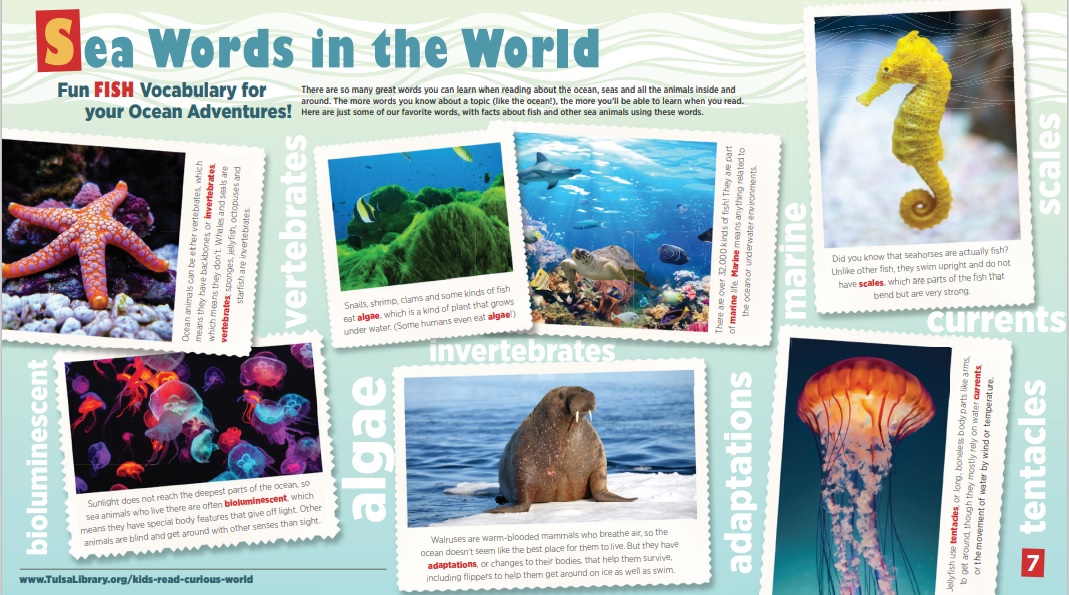
Read All About It! A Note for Parents
How can you use the Kids Read Curious World magazine and its parts to help your child with their reading?
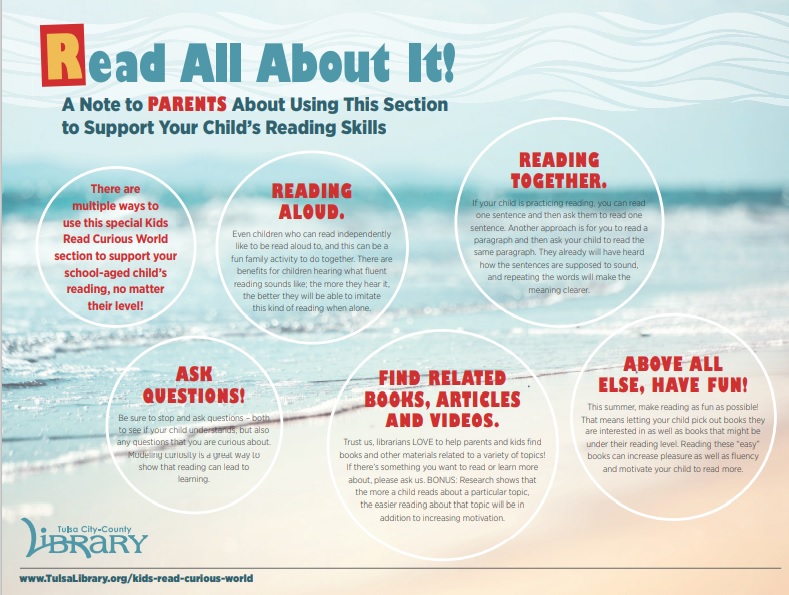
Read All About It!
A Note to Parents About Using This Section to Support Your Child’s Reading Skills
There are multiple ways to use this special “Kids Read Curious World” magazine to support your school-aged child’s reading, no matter their level!
Reading aloud.
Even children who can read independently like to be read aloud to, and this can be a fun family activity to do together. There are benefits for children hearing what fluent reading sounds like; the more they hear it, the better they will be able to imitate this kind of reading when alone.
Reading together.
If your child is practicing reading, you can read one sentence and then ask them to read one sentence. Another approach is for you to read a paragraph, and then ask your child to read the same paragraph. They will have already heard how the sentences are supposed to sound, and repeating the words will make the meaning clearer.
Ask questions!
Be sure to stop and ask questions – both to see if your child understands, but also any questions that you are curious about. Modeling curiosity is a great way to show that reading can lead to learning.
Find related books, articles, and videos.
Trust us, librarians LOVE to help parents and kids find books and other materials related to a variety of topics! If there’s something you want to read or learn more about, please ask us. BONUS: research shows that the more a child reads about a particular topic, the easier reading about that topic will be in addition to increasing motivation.
Above all else, have fun!
This summer, make reading as fun as possible! That means letting your child pick out books they are interested in as well as books that might be under their reading level. Reading these “easy” books can increase pleasure as well as fluency and motivate your child to read more.
#1 Way to Build Your Story: Story Ideas!

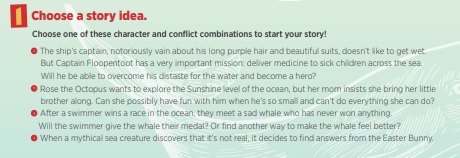
1. Choose A Story Idea.
Choose one of these character and conflict combinations to start your story!
- The ship’s captain, notoriously vain about his long purple hair and beautiful suits, doesn’t like to get wet. But Captain Floopentoot has a very important mission: deliver medicine to sick children across the sea. Will he be able to overcome his distaste for the water and become a hero?
- Rose the Octopus wants to explore the Sunshine level of the ocean, but her mom insists she bring her little brother along. Can she possibly have fun with him when he’s so small and can’t do everything she can do?
- After a swimmer wins a race in the ocean, they meet a sad whale who has never won anything. Will the swimmer give the whale their medal? Or find another way to make the whale feel better?
- When a mythical sea creature discovers that it’s not real, it decides to find answers from the Easter Bunny.
#2 Way to Build Your Story: Doodles!

#3 Way to Build Your Story: Story Starters!

3. Begin with a Story Starter!
Use these opening sentences to help get your story started!
- “What is that?” my sister pointed behind me on the beach. I turned around and saw…
- I’m just your everyday, average, rainbow-colored penguin. I’m not special. Well, maybe a little.
- People think dolphins are smart, but I’m here to tell you: they are also really annoying!
- My submarine broke down again. Third time in four days. How am I ever going to get to the Caribbean Sea now?
- I swam up to my classroom on the first day of fourth grade.
Whale Facts for Your Story!
Write with these whale facts in mind!
See if you can use any of these whale facts in your story!
- The largest mammal in the world doesn’t live on land – it lives under water! The blue whale is about as big as 2 and a half school buses put together. A blue whale’s tongue can be as heavy as an entire elephant’s body!
- Whales didn’t start out as sea animals. They evolved from 4-legged land animals. Over time, their arms turned to flippers and they lost their legs!
- Sometimes sperm whales must dive into deep waters to hunt. When this happens and they have small babies, they leave their babies with “babysitter” whales while they are gone.
- In fact, orca whales frequently live for over 100 years! Grandmother orca whales often care for their grandchildren, helping out their daughters by sharing food and looking after the young whales as they grow.
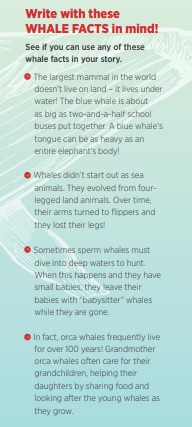
7 Things To Know About Oceans
Download and print this article about oceans, written for kids!
https://www.tulsalibrary.org/sites/default/files/2022-06/7%20Things%20To%20Know%20About%20Oceans.pdf
Aquarium Librarian!
Read all about Ms. Tori, a librarian who also volunteers for an aquarium!
https://www.tulsalibrary.org/sites/default/files/2022-06/Aquarium%20Librarian%20article.pdf
Tori Hamilton – better known as “Ms. Tori” – has been a Children’s Associate at the Glenpool Library for more than six years. But she also loves the Oklahoma Aquarium and all things ocean! Read this interview with Ms. Tori…
Question: You work at the Glenpool Library helping children and families find great books and information. But you have also been a volunteer with the Oklahoma Aquarium. The library's summer reading program theme this year is "OCEANS" - what does it feel like to bring together "Aquarium Tori" with "Librarian Tori" in this way?
Answer: It’s pretty great! The summer reading program is usually a busy time for librarians, but I feel uniquely prepared this year. Haha!
Q: How did you get interested in ocean animals and the aquarium? What is your favorite thing to do as a volunteer for the aquarium?
A: I’m a lifelong animal lover so when the opportunity came to volunteer at the Aquarium, I jumped at it. I was an active weekly volunteer for two years, though these days I only go in when they need help with big events.
My favorite part of volunteering is talking to people about the exhibits. When people say, “Wow! Look at that!”, I love being able to say, “Right? But did you know...” There’s nothing like sharing enthusiasm for cool things with an equally enthusiastic audience.
Q: Do you have any fond ocean memories? For someone who is going to the ocean for the first time, what do you recommend they do?
A: Well, all of my ocean memories are fond ones! It’s hard to have a bad time at the beach! If you’re going for the first time, try everything! Walk barefoot in the sand, dig for shells, float in the water, and read under a colorful umbrella. You never know which parts will be your favorites.
Q: What is your absolute, all-time favorite ocean animal? Why?
A: I love octopuses! They’re just so amazing! I can go on and on about how great they are. (In fact, I wrote a list of cool octopus facts, in this very guide you are reading!)
Q: You are known for singing and playing guitar in your storytimes at the Glenpool Library. Do you have a favorite ocean-themed song that you think kids will like? What makes it a good song?
A: I love the old campfire song, “Barges” about watching ships in the harbor. It’s upbeat and catchy. So cheerful!
*NOTE TO READERS: Watch Ms. Tori sing this song at www.youtube.com/tulsalibrary!
Q: You also like to do yoga moves in storytime. Any ocean yoga move kids could easily do?
A: Of course! My favorite “ocean” pose is Warrior 2. Technically, it has nothing to do with the ocean, but it’s perfect for pretending you’re surfing while you build strong surfing muscles!
Q: What do you want kids to get out of the summer reading program? Any words of advice or wisdom for them? What does the library have to offer them?
A: Mostly, I want kids to know it’s not just about the books! It’s about what’s inside them. Knowledge and stories, cool pictures and cool facts. Reading doesn't have to be boring if you read about things you love.
Meet Waffles, the Library Fish!
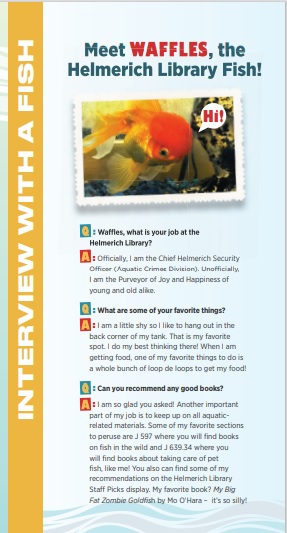
Q. Waffles, what is your job at the Peggy Helmerich Library?
Officially, I am the Chief Helmerich Security Officer (Aquatic Crimes Division). Unofficially, I am the Purveyor of Joy and Happiness of young and old alike.
Q. What are some of your favorite things?
I am a little shy so I like to hang out in the back corner of my tank. That is my favorite spot. I do my best thinking there! When I am getting food, one of my favorite things to do is a whole bunch of loop-de-loops to get my food!
Q. Can you recommend any good books?
I am so glad you asked! Another important part of my job is to keep up on all aquatic related materials. Some of my favorite sections to peruse are J 597 where you will find materials books on fish in the wild and J 639.34 where you will find books about taking care of pet fish, like me! You can also find some of my recommendations on the PH Staff Picks display. My favorite book? My Big Fat Zombie Goldfish by Mo O'Hara - it's so silly!
